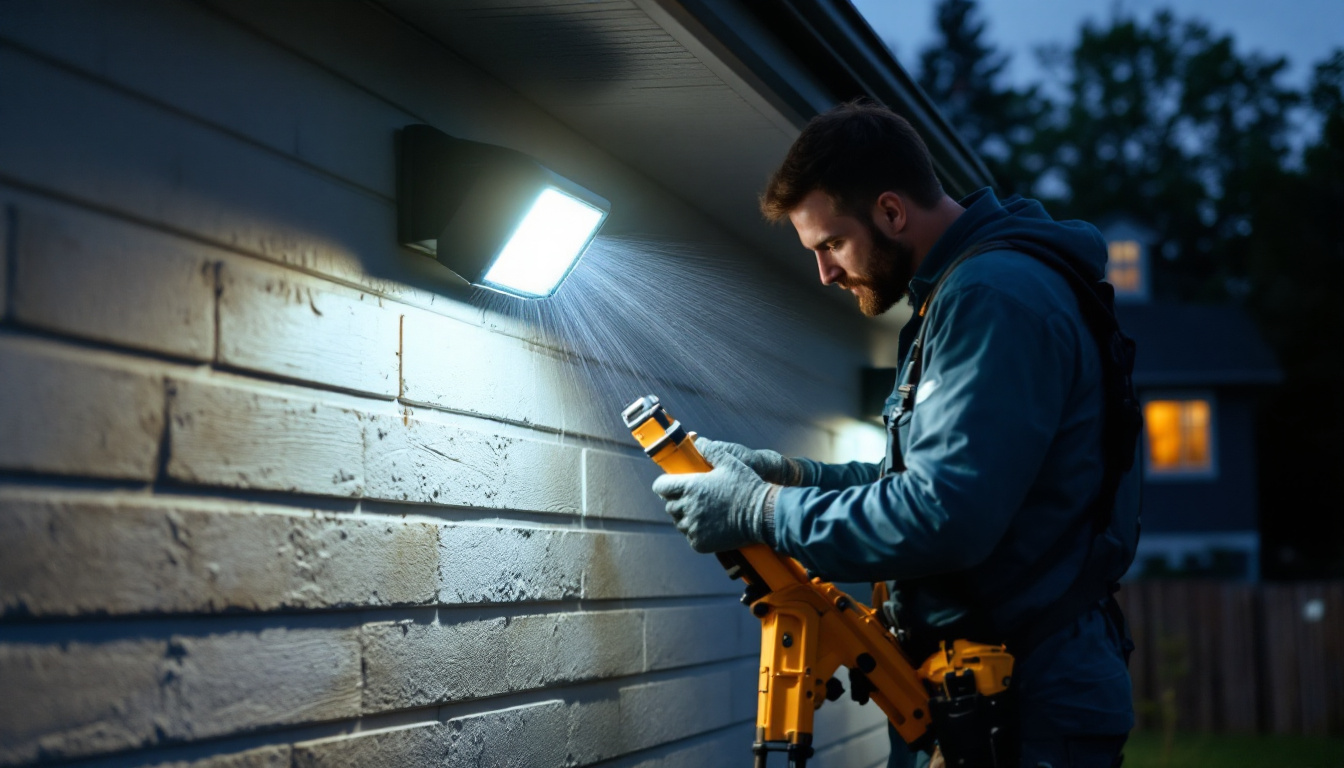
outdoor motion lights are a vital component of residential and commercial security systems. They not only enhance safety by illuminating dark areas but also deter potential intruders. However, lighting contractors often face challenges when installing these systems. This article explores common issues and provides practical solutions to ensure successful installations.
Before diving into installation challenges, it’s essential to understand how motion sensors work. Motion lights typically use passive infrared (PIR) sensors to detect movement. These sensors identify changes in heat signatures, activating the light when a warm body passes within their range. Familiarity with this technology can help contractors avoid common pitfalls. Additionally, understanding the sensitivity settings of these sensors can be crucial, as overly sensitive settings may lead to frequent activations from small animals or even moving foliage, while settings that are too low might fail to detect larger movements.
There are several types of motion sensors available, each with its unique features and applications. The most common types include:
Understanding these types allows contractors to choose the right sensor for specific applications, enhancing performance and reliability. For instance, in areas with heavy foot traffic, dual technology sensors may be preferable due to their reduced likelihood of false alarms, while PIR sensors might be ideal for residential settings where cost-effectiveness is a priority. Furthermore, some advanced models come equipped with adjustable detection ranges and sensitivity settings, allowing for greater customization based on the specific environment.
Despite the advantages of motion lights, several installation challenges can arise. These include:
Addressing these challenges proactively can save time and resources, ensuring a smoother installation process. For example, conducting a thorough site assessment before installation can help identify optimal sensor placement, taking into account potential obstructions and the typical movement patterns of individuals in the area. Additionally, using weather-resistant models in outdoor settings can mitigate the impact of environmental factors. It’s also advisable to test the sensors after installation to ensure they function as intended, allowing for any necessary adjustments to be made promptly.
The placement of outdoor motion lights is critical to their effectiveness. A well-thought-out location maximizes the sensor’s range and minimizes false alarms. Here are some key considerations for lighting contractors.
Installing motion lights at the correct height and angle is crucial. Typically, sensors should be mounted between 6 to 10 feet above the ground. This height allows for optimal detection while minimizing the risk of false triggers from small animals or moving foliage.
Additionally, the angle of the sensor should be adjusted to cover the desired area without pointing directly at busy streets or areas with frequent movement. This adjustment can significantly reduce nuisance alarms. It is also beneficial to test the sensor’s range after installation, as different models may have varying detection capabilities. A simple walk test can help ensure that the sensor picks up movement only in the intended zones, providing peace of mind and enhancing security.
Environmental factors can greatly affect the performance of motion lights. For instance, installing lights near trees or shrubs can lead to false alarms due to moving branches or wildlife. Contractors should assess the surrounding environment and choose locations that are less likely to be disturbed by natural elements.
Moreover, consider the exposure to weather conditions. Lights should be positioned to avoid direct exposure to rain or snow, which can affect their functionality over time. Additionally, the type of lighting used can influence performance; for example, LED lights are often more durable and resistant to harsh weather compared to traditional bulbs. It’s also wise to check for potential obstructions that could block the sensor’s view, such as fences or garden structures, which could hinder its effectiveness. By taking these environmental factors into account, contractors can ensure that the motion lights operate reliably and efficiently throughout the year.
Electrical issues are among the most common problems encountered during the installation of outdoor motion lights. Proper planning and execution can prevent these issues from arising.
Before installation, it is essential to ensure that the wiring and power supply are adequate for the lights being installed. Contractors should verify that the circuit can handle the load and that the wiring is suitable for outdoor use. Using weatherproof conduit and connectors can help prevent electrical failures caused by moisture.
Additionally, it’s wise to check local codes and regulations regarding electrical installations. Compliance with these standards not only ensures safety but also enhances the longevity of the lighting system.
After installation, testing the motion lights is crucial. This step involves checking the sensor’s responsiveness and ensuring that the lights activate as intended. Contractors should simulate movement in the sensor’s range to confirm proper functionality.
Any issues identified during testing should be addressed immediately. This proactive approach can prevent future problems and enhance customer satisfaction.
Customers may have various concerns regarding outdoor motion lights, and addressing these proactively can enhance the contractor-client relationship. Understanding these concerns allows contractors to provide better service and support.
One of the most common concerns customers have is false alarms. These can be triggered by pets, passing vehicles, or even weather conditions. Educating customers about the factors that can lead to false alarms is essential.
Contractors can recommend adjustments to the sensor’s sensitivity settings or suggest alternative locations that minimize these occurrences. Providing clear instructions on how to operate and adjust the system can also empower customers to manage their lighting effectively.
Customers often worry about the maintenance and longevity of outdoor motion lights. It’s important to communicate that regular maintenance can extend the life of the system. Simple tasks such as cleaning the sensor lenses and checking for debris can significantly enhance performance.
Contractors should provide customers with a maintenance schedule and tips for keeping their motion lights in optimal condition. This guidance not only helps in maintaining functionality but also fosters trust and reliability.
Outdoor motion lights serve a critical role in enhancing security. However, their effectiveness can be maximized through strategic installation and integration with other security systems.
Many homeowners are now opting for smart home systems that allow for remote control and monitoring of various devices, including outdoor lighting. Contractors should be familiar with these technologies and how to integrate motion lights into smart home systems.
By doing so, customers can receive alerts on their smartphones when motion is detected, providing an added layer of security. Educating clients about the benefits of such integrations can also enhance the overall value of the installation.
While motion lights are effective on their own, combining them with other security measures can create a more robust defense. For instance, pairing motion lights with security cameras can provide visual verification of any activity detected by the lights.
Contractors should discuss these options with clients, helping them understand the benefits of a comprehensive security system. This approach not only enhances safety but also positions the contractor as a knowledgeable resource in security solutions.
The lighting industry is continually evolving, with new technologies and trends emerging regularly. Staying informed about these changes can help contractors provide the best solutions for their clients.
With growing concerns about energy consumption, many customers are seeking energy-efficient lighting options. LED motion lights are becoming increasingly popular due to their low energy usage and long lifespan. Contractors should be knowledgeable about these options and their benefits.
By offering energy-efficient solutions, contractors can appeal to environmentally conscious clients and contribute to sustainability efforts.
Technological advancements are also influencing outdoor motion lighting. Innovations such as solar-powered lights and smart sensors that can learn and adapt to their environment are becoming more prevalent. Contractors should stay updated on these trends to offer cutting-edge solutions to their clients.
Participating in industry workshops, webinars, and trade shows can help contractors remain informed and competitive in the market.
Outdoor motion lights are an essential aspect of modern security systems, providing safety and peace of mind. However, lighting contractors must navigate various challenges to ensure successful installations. By understanding motion sensor technology, choosing the right locations, addressing electrical considerations, and staying informed about industry trends, contractors can enhance their service and avoid common issues.
Ultimately, a proactive approach to installation and customer education will lead to satisfied clients and a successful lighting business. Embracing these strategies not only enhances the functionality of outdoor motion lights but also solidifies the contractor’s reputation as a trusted expert in the field.
Ready to elevate your lighting installations with the best in the business? Look no further than LumenWholesale for all your outdoor motion light needs. Our extensive selection of spec-grade lighting products ensures you have access to the highest quality options for your security system projects. With unbeatable wholesale prices and the convenience of free shipping on bulk orders, you can trust that you’re getting superior value without any hidden costs. Make your next project a shining success and experience wholesale lighting at the best value today with LumenWholesale.

Discover effective strategies and proven techniques for lighting contractors to successfully retrofit LED can lights.

Discover how lighting contractors can enhance their projects with 12V LED light transformers.

Discover the essential considerations for lighting contractors when choosing solar light stands.

Discover the crucial warehouse fixtures that lighting contractors frequently miss.